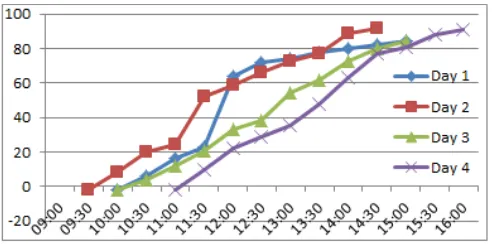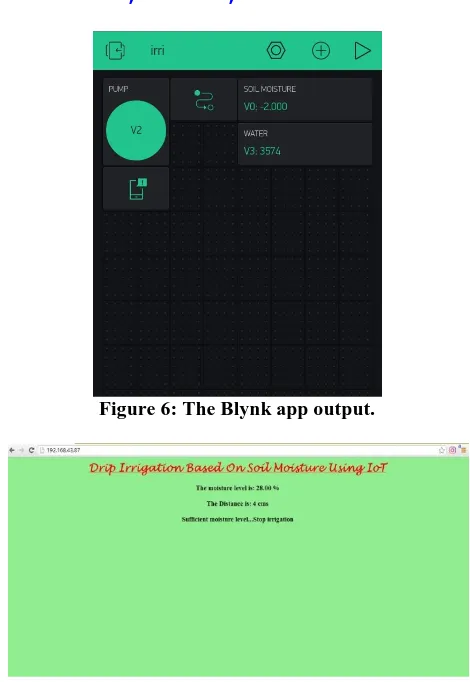ISSN(Online): 2320-9801 ISSN (Print): 2320-9798
I
nternational
J
ournal of
I
nnovative
R
esearch in
C
omputer
and
C
ommunication
E
ngineering
(A High Impact Factor, Monthly, Peer Reviewed Journal) Website: www.ijircce.com
Vol. 7, Issue 11, November 2019
Drip Irrigation Based on Soil Moisture
using IOT
Akshay M J, Amulya H N, Anchitha K R, Nischitha A C, Priya Satish
Department of Information Science and Engineering, Jawaharlal Nehru National College of Engineering, Shivamogga,
Karnataka, India
ABSTRACT:Agriculture contributes highest to India’s economy. It is found that the development is not tremendous when considered technology that is deployed in this field. Therefore the development of agriculture is important in terms of technology. Even today most of the irrigation systems are operated manually. The available traditional techniques are like drip irrigation, sprinkler irrigation etc are needed to be combined with IoT so that farmers can make use of water very efficiently. IoT helps to access information and make major decision making process by getting different values from sensors like soil moisture, water level sensors etc. This paper focuses primarily on reducing the wastage of water and minimizing the manual labor on field for irrigation so this can save time, labor cost and power of the farmer.
KEYWORDS: IoT, NodeMCU ESP8266, Blynk, Ultrasonic sensor, Soil moisture sensor.
I. INTRODUCTION
Agriculture is the strength of Indian Economy. However, water required for agriculture is more than rainfall every year. Improving farm yield is essential to meet the rapidly growing demand of food for population growth across the world.
Applying controlled amount of water to plants at required intervals is Irrigation. Irrigation helps to grow agricultural crops, maintain landscapes and revegetate disturbed soils in dry areas and during the periods of less than average rainfall. There are many different types of irrigation system, depending on how the water is distributed throughout the field.
Drip irrigation system allows water to drip slowly to the area where water is required that is the root zone of the plants there by saving the water, either from above the soil surface or buried below the surface. The intention is to apply water directly to the root zone and minimize water evaporation. Compared to surface irrigation or sprinkler irrigation, drip irrigation can be more efficient.
Interconnection of number of devices through internet describes the Internet of things (IoT) [1]. Every object is connected with each other through unique identifier so that data can be transferred without human to human interaction. The IoT is the network of physical objects- devices, vehicles, buildings and other items embedded with electronics, software, sensors and network connectivity that enable these objects to collect and exchange data.
ISSN(Online): 2320-9801 ISSN (Print): 2320-9798
I
nternational
J
ournal of
I
nnovative
R
esearch in
C
omputer
and
C
ommunication
E
ngineering
(A High Impact Factor, Monthly, Peer Reviewed Journal) Website: www.ijircce.com
Vol. 7, Issue 11, November 2019
II. RELATED WORK
Plenty of research work has been done to improve the performance of agriculture field. Shweta B Saraf and Dhanashri H. Gawali [1] evaluate a cloud-based wireless communication system to monitor and control a set of sensors and actuators to assess the plants water needs. Zigbee is used for communication between sensor nodes and base station. Real time sensed data handling and demonstration on the server is accomplished using web based java graphical user interface. Wireless monitoring of field irrigation system reduces human intervention and allows remote monitoring and controlling on android phone.
K. M. Ragibul Haque; M Abu Muyeed ; Shahriar Sadat ; Rajesh Palit [2], A solar panel is used which is going to charge the battery, and that battery will run the water pump. A Light Dependent Resistor (LDR) is being used to determine whether there is light available or not. At the presence of sunlight, the water pump will stop automatically. When it is dark, it will provide indication for the pump to begin the water to flow. The LEDs are used to show the output, so that a person can easily know the condition of the water level and as well as the sunlight.
In Karan Kansara et al [3], the system checks the temperature, and humidity of soil to retain the nutrient composition of the soil managed for proper growth of plant. The system is low cost and effective with less power consumption using sensors for remote monitoring and controlling devices which are controlled via SMS using a GSM using android mobile.
In S Nalini Durga, M Ramakrishna [4], if the moisture level goes below the desired and limited level, the moisture sensor sends the signal to the Arduino board which triggers the Water Pump to turn ON and supply the water to respective plant. When the desired moisture level is reached, the system halts on its own and the water Pump is turned OFF.
P. Suganya et al describes as follows [5]: the soil moisture the sensors are deployed in the field. The data collected from the sensors are sent to the database via the android application. In control section, the system is turned on using the application, this is done using the on\off buttons in the application. Also, this system is turned on automatically when the moisture of the soil is low, the pump is turned on and depending on the moisture content. In manual mode, there is a manual switch in the field to make sure that if the system fails, one can turn off the water supply manually.
In Srishti Ra [6], the information from sensors is transmitted to an online database from where it is used to display on a website. The threshold values depend on the type of soil used. Readings from the two sensors were also transmitted to a THINGSPEAK channel to obtain graphs.
III. PROPOSED SYSTEM
The system helps user to improve quality and quantity of their farm yield by sensing soil moisture value and water level of the tank from the field without any human intervention. By using the concept of IoT system can be more efficient.
The system contains sensor units placed in the field to acquire the real time values, a nodemcu to receive and transmit acquired information to the control section, and a control section which controls the drips for watering subsystem. The sensed data from node is transmitted to the nodemcu.
The received data is stored at the nodemcu. It performs decision making by comparing between sensed values and predefined threshold values as per crop selection. The microcontroller controls relay switching unit and watering subsystem accordingly.
ISSN(Online): 2320-9801 ISSN (Print): 2320-9798
I
nternational
J
ournal of
I
nnovative
R
esearch in
C
omputer
and
C
ommunication
E
ngineering
(A High Impact Factor, Monthly, Peer Reviewed Journal) Website: www.ijircce.com
Vol. 7, Issue 11, November 2019
The NodeMcU is a tool for making computers that can sense and control more of the physical world than desktop computer. It’s an open-source physical computing platform based on a simple micro-controller board and a development environment for writing software for the board.
Figure 1: Flow Chart
ISSN(Online): 2320-9801 ISSN (Print): 2320-9798
I
nternational
J
ournal of
I
nnovative
R
esearch in
C
omputer
and
C
ommunication
E
ngineering
(A High Impact Factor, Monthly, Peer Reviewed Journal) Website: www.ijircce.com
Vol. 7, Issue 11, November 2019
Fig 2: System Architecture
The overall system architecture involving the hardware components is depicted in fig 2. It consists of ESP8266 NodeMCU, Soil moisture sensor, water level sensor, Relay module, Pump and power supply.
IV. RESULT AND DISCUSSION
The proposed system is designed to supply proper amount of water directly to the root zone of the plant thereby reducing wastage of water. The system is intended to provide proper irrigation for single kind of crop.
The threshold value for the plant is fixed by observing continuously for few days and according to the plant requirement. The system checks the moisture level for certain time interval depending upon the plant.
Table 1: Comparison between Tomato and Brinjal plant
Tomato plant Brinjal plant
Needs water Less More
Water sensitive Yes No
Life span 60-80 days 2-3 years
ISSN(Online): 2320-9801 ISSN (Print): 2320-9798
I
nternational
J
ournal of
I
nnovative
R
esearch in
C
omputer
and
C
ommunication
E
ngineering
(A High Impact Factor, Monthly, Peer Reviewed Journal) Website: www.ijircce.com
Vol. 7, Issue 11, November 2019
Every half an hour the soil moisture values are checked. It is observed that from 12PM to 4:30PM water requirement is more.
Figure 4: The soil moisture vs time graph of four days after the implementation of proposed system.
The chart showed in figure 4 shows the soil moisture value vs time graph of tomato plant for four simultaneous days after the implementation of the proposed system. It is observed that the soil moisture content is maintained constant throughout the day.
Figure 5: Hardware setup of drip irrigation system.
The system’s hardware setup is shown in figure 5. The whole setup is kept in the field.
ISSN(Online): 2320-9801 ISSN (Print): 2320-9798
I
nternational
J
ournal of
I
nnovative
R
esearch in
C
omputer
and
C
ommunication
E
ngineering
(A High Impact Factor, Monthly, Peer Reviewed Journal) Website: www.ijircce.com
Vol. 7, Issue 11, November 2019
Figure 6: The Blynk app output.
Figure 7: Web page output when sufficient water is supplied.
If sufficient water is supplied then the message to stop the irrigation is displayed along with the moisture level percentage and water level distance in tank in web page which is shown in figure 7.
V. CONCLUSION
The proposed system can be used to switch on/off the drippers according to soil moisture levels thereby automating the process of irrigation which is one of the most time consuming activities in farming. Our system has been tested to function automatically and manually as well. The soil moisture sensor measure the moisture level (water content) in the soil. If the moisture level goes below the desired level, the moisture sensor sends the signal to the NodeMCU board which triggers the Water Pump to turn ON and supply the water to plant. When the desired moisture level is reached, the system halts on its own and the water Pump is turned OFF. The observations and results shows that this solution can be implemented for reduction of water loss and reduce the man power required for a field.
ISSN(Online): 2320-9801 ISSN (Print): 2320-9798
I
nternational
J
ournal of
I
nnovative
R
esearch in
C
omputer
and
C
ommunication
E
ngineering
(A High Impact Factor, Monthly, Peer Reviewed Journal) Website: www.ijircce.com
Vol. 7, Issue 11, November 2019
REFERENCES
1. Shweta B Saraf and Dhanashri H. Gawali: “IoT Based Smart Irrigation Monitoring And Controlling System”, 2017 2nd IEEE International
Conference on Recent Trends in Electronics Information & Communication Technology (RTEICT), May 19-20, 2017, India.
2. K. M. Ragibul Haque; M Abu Muyeed ; Shahriar Sadat ; Rajesh Palit: “Jol-Shinchon: Design and Development of a Sensor Based
IntelligentAuto Irrigation System”, 2017 IEEE 7th Annual Computing and Communication Workshop and Conference (CCWC), 9-11 Jan. 2017, Las Vegas, NV, USA.
3. Karan Kansara, Vishal Zaveri, Shreyans Shah, Sandip Delwadkar, Kaushal Jani : “Sensor based Automated Irrigation System with IOT”, Karan
Kansara et al, (IJCSIT) International Journal of Computer Science and Information Technologies, Vol. 6 (6) , 2015, 5331-5333.
4. S Nalini Durga, M Ramakrishna: “Smart Irrigation system based on soil moisture using IoT”, International Research Journal of Engineering
and Technology (IRJET), Volume: 05 Issue: 06 | June 2018.
5. P. Suganya, Aditya Subramanian, Yagneshwaran. B, Farheen Khan, S.R Sushmitha: “Automatic Irrigation System using IoT”, International
Research Journal of Engineering and Technology (IRJET), Volume: 04 Issue: 10 | Oct -2017.
6. Srishti Rawal: “IOT based Smart Irrigation System”, International Journal of Computer Applications (0975 – 8887) Volume 159 – No 8,



